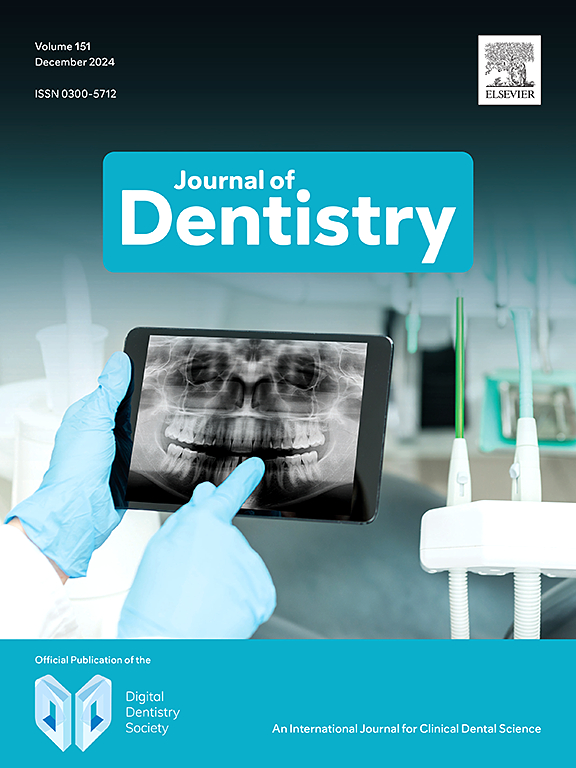Automated dental registration and TMJ segmentation for virtual surgical planning of orthognathic surgery via three-step computer-based method
IF 4.8
2区 医学
Q1 DENTISTRY, ORAL SURGERY & MEDICINE
引用次数: 0
Abstract
Objective
This study developed and evaluated a computer-based method for automating the registration of scanned dental models with 3D reconstructed skulls and segmentation of the temporomandibular joint (TMJ).
Methods
A dataset comprising 1274 skull models and corresponding scanned dental models was collected. In total, 1066 cases were used for the development of the computer-based method, while 208 cases were used for validation. Performance was evaluated by comparing the automated results with manual registration and segmentation performed by clinicians, using accuracy and completeness metrics (e.g. intersection of union [IoU] and Dice similarity coefficient [DSC]).
Results
The automated registration achieved a mean absolute error of 0.35 mm for the maxilla and 0.38 mm for the mandible, and a root mean squared error of 0.46 mm and 0.39 mm, respectively. The automatic TMJ segmentation exhibited an accuracy of 97.48 %, a precision of 97.06 %, a IoU of 95.72 %, DSC of 97.3 %, and a Hausdorff value of 1.87 mm, which were sufficient for clinical application.
Conclusion
The proposed method significantly improved the efficiency of orthognathic surgical planning by automating the registration and segmentation processes. The accuracy and precision of the automated results were sufficient for clinical use, reducing the workload on clinicians and facilitating faster and more reliable surgical planning.
Clinical significance
The computer-based method streamlines orthognathic surgical planning, enhancing precision and efficiency without compromising clinical accuracy, ultimately improving patient outcomes and reducing the workload of surgeons.
通过基于计算机的三步法为正颌外科手术的虚拟手术规划自动进行牙齿注册和颞下颌关节分割。
目的:本研究开发并评估了一种基于计算机的方法,用于将扫描的牙科模型与三维重建的头骨进行自动配准,并对颞下颌关节进行分割:本研究开发并评估了一种基于计算机的方法,用于将扫描的牙科模型与三维重建的头骨进行自动配准,并对颞下颌关节(TMJ)进行分割:方法:收集了由 1274 个头骨模型和相应的扫描牙科模型组成的数据集。共有 1066 个病例用于开发基于计算机的方法,208 个病例用于验证。通过使用准确性和完整性指标(如联合交点 [IoU] 和 Dice 相似性系数 [DSC])将自动结果与临床医生进行的手动配准和分割进行比较,对性能进行评估:自动配准的平均绝对误差分别为:上颌骨 0.35 毫米,下颌骨 0.38 毫米,均方根误差分别为 0.46 毫米和 0.39 毫米。颞下颌关节自动分割的准确度为 97.48%,精确度为 97.06%,IoU 为 95.72%,DSC 为 97.3%,Hausdorff 值为 1.87 mm,足以满足临床应用的需要:结论:所提出的方法通过实现注册和分割过程的自动化,极大地提高了正颌外科手术规划的效率。结论:所提出的方法通过自动注册和分割过程,大大提高了正颌外科手术规划的效率,自动结果的准确性和精确性足以满足临床应用的需要,减轻了临床医生的工作量,有利于更快、更可靠地制定手术规划:临床意义:基于计算机的方法简化了正颌外科手术规划,在不影响临床准确性的前提下提高了精确度和效率,最终改善了患者的治疗效果,减轻了外科医生的工作量。
本文章由计算机程序翻译,如有差异,请以英文原文为准。
求助全文
约1分钟内获得全文
求助全文
来源期刊

Journal of dentistry
医学-牙科与口腔外科
CiteScore
7.30
自引率
11.40%
发文量
349
审稿时长
35 days
期刊介绍:
The Journal of Dentistry has an open access mirror journal The Journal of Dentistry: X, sharing the same aims and scope, editorial team, submission system and rigorous peer review.
The Journal of Dentistry is the leading international dental journal within the field of Restorative Dentistry. Placing an emphasis on publishing novel and high-quality research papers, the Journal aims to influence the practice of dentistry at clinician, research, industry and policy-maker level on an international basis.
Topics covered include the management of dental disease, periodontology, endodontology, operative dentistry, fixed and removable prosthodontics, dental biomaterials science, long-term clinical trials including epidemiology and oral health, technology transfer of new scientific instrumentation or procedures, as well as clinically relevant oral biology and translational research.
The Journal of Dentistry will publish original scientific research papers including short communications. It is also interested in publishing review articles and leaders in themed areas which will be linked to new scientific research. Conference proceedings are also welcome and expressions of interest should be communicated to the Editor.
 求助内容:
求助内容: 应助结果提醒方式:
应助结果提醒方式:


